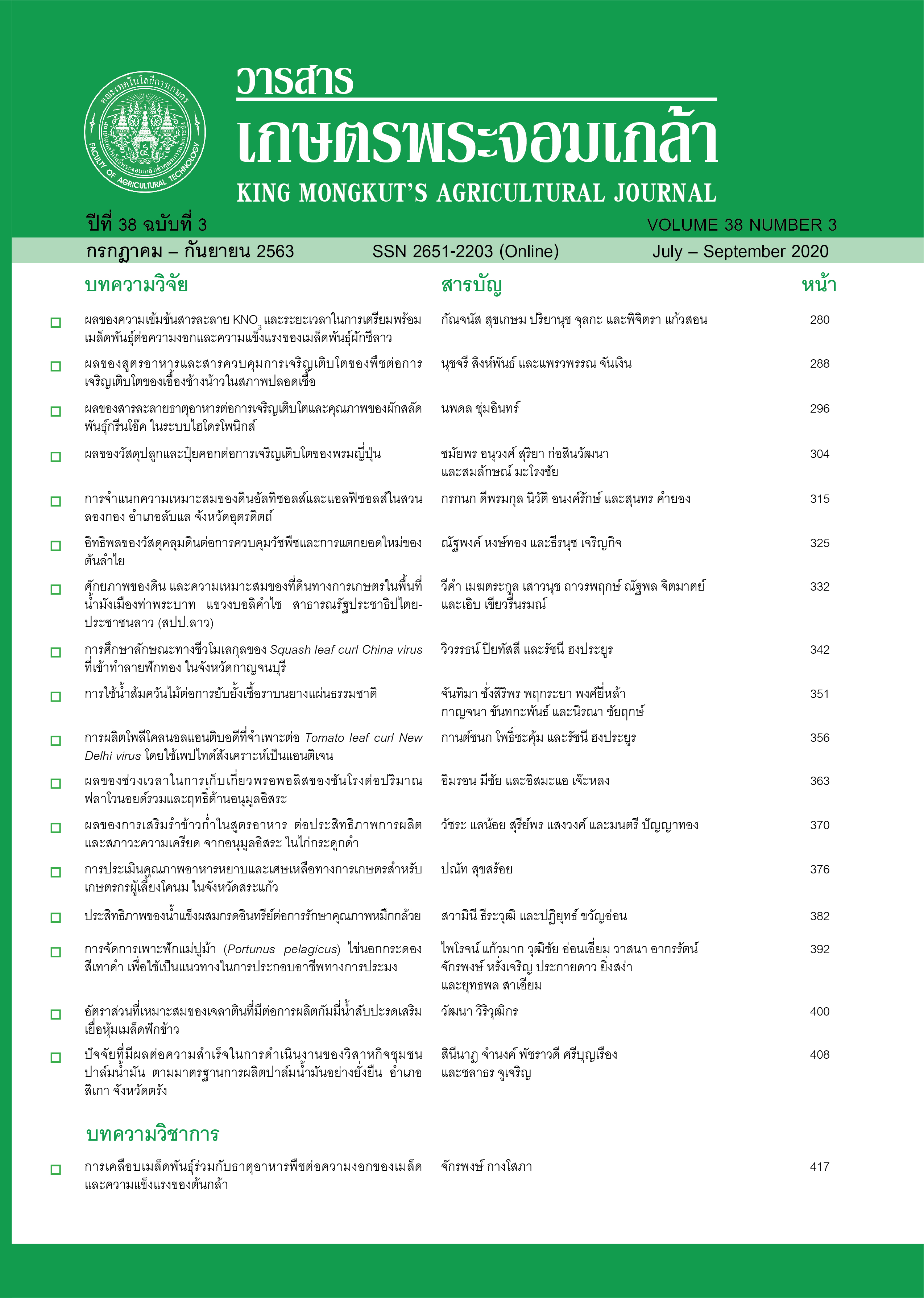การใช้น้ำส้มควันไม้ต่อการยับยั้งเชื้อราบนยางแผ่นธรรมชาติ
Main Article Content
บทคัดย่อ
น้ำส้มควันไม้เป็นของเหลวที่ได้จากการเผาถ่านในสภาวะอับอากาศจัดเป็นสารจากธรรมชาติที่สามารถใช้ในอุตสาหกรรมการเกษตร อาหาร และยา เนื่องจากมีคุณสมบัติเป็นกรดและยับยั้งการเจริญเติบโตของเชื้อจุลินทรีย์จึงเป็นที่สนใจในการนำมาใช้สำหรับการยับยั้งเชื้อราบนยางแผ่น งานวิจัยนี้มีวัตถุประสงค์เพื่อศึกษาองค์ประกอบและประสิทธิภาพการยับยั้งเชื้อราของน้ำส้มควัน 3 ชนิด ได้แก่ น้ำส้มควันจากไม้ไผ่ น้ำส้มควันจากไม้ยางพารา และน้ำส้มควันจากไม้ยูคาลิปตัส วิเคราะห์สารประกอบอินทรีย์ในน้ำส้มควันไม้โดยวิธี GC-MS ดำเนินการทดลองยับยั้งเชื้อราบนยางแผ่นดิบด้วยน้ำส้มควันไม้ที่ความเข้มข้นร้อยละ 10, 20 และ 30 โดยปริมาตร ผลการศึกษาพบว่า สารสำคัญในน้ำส้มควันไม้ประกอบด้วยกรดอินทรีย์ต่าง ๆ ได้แก่ กรดแอซีติก กรดโพรพาโนอิก และกรดบิวทาโนอิก และส่วนประกอบฟีนอลิก เช่น ฟีนอลและครีซอล ทั้งนี้องค์ประกอบและปริมาณของสารสำคัญในน้ำส้มควันไม้ทั้ง 3 ชนิดมีความคล้ายคลึงกัน นอกจากนี้ยังพบว่า น้ำส้มควันไม้ทั้ง 3 ชนิดมีประสิทธิภาพยับยั้งเชื้อราบนยางแผ่นได้มากกว่า 90%
Article Details

อนุญาตภายใต้เงื่อนไข Creative Commons Attribution-NonCommercial-NoDerivatives 4.0 International License.
วารสารเกษตรพระจอมเกล้า
เอกสารอ้างอิง
Akakabe, Y., Tamaru, Y., Takabayashi, M., Iwamoto, S., and Nyugaku., T. 2006. Volatile organic compounds with characteristic odor
in bamboo vinegar. Bioscience Biotechnology and Biochemistry 70: 2797-2799.
Amen-Chen, C., Pakdel, H., and Roy, C. 2001. Production of monomeric phenols by thermochemical conversion of biomass:
a review. Bioresource Technology 79: 277-299.
Baimark, Y., and Niamsa, N. 2009. Study on WVs for use as coagulating and anti-fungal agents on the production of natural rubber sheets. Biomass and Bioenergy 33: 994-998.
Bunsan, T. 2009. Study on the effect of soil-based wood vinegar for growing Chinese kale. Nakhon Sawan: Nakhon Sawan Rajabhat University.
Prepram, T. 2012. The disadvantage of using bio-fermented water and wood vinegar in the coagulation of rubber. Journal of natural 33: 2-18.
Puttinun, P. 2011. Wood vinegar. Natural Agriculture 9: 928-933. (in Thai).
Rattanaporn, K., Darunee, C., Sanun, J., Sadudee, W., and Sopon, V. 2008. Effect of wood vinegar on growth and yield of
groundnut seeds, Khon Kaen 6 and Tainan 9 seed species. Journal of Agriculture 36: 125-132.
Tournas, V., Stack, M. E., Mislivec, P. B., Kock, H. A., and Bandler, R. 2015. Bacteriological analytical manual chapter 18,
yeasts, molds, and mycotoxin. U.S. Food and Drug Administration; 2001. https://www.fda.gov/Food/FoodScienceResearch/Laboratory Methods/ucm071435.htm. (10 May 2015).
Velmurugan, N., Hanand, S. S., and Lee, Y. S. 2009. Anti-fungal activity of neutralized wood vinegar with water extracts of
Pinus densiflora and Quercus serrata saw dusts. International Journal of Environmental Research 3: 167-176.
Yagi, T., and Tsukamoto, S. 1991. Development of phytopathogenic fungi on the media containing WV.
In Proceeding of the Association of Plant Protection. pp. 93-98. Japan: Hokuriku.
Yaman, S. 2004. Pyrolysis of biomass to produce fuels and chemical feedstocks. Energy Conversion and Management 45: 651-671.


